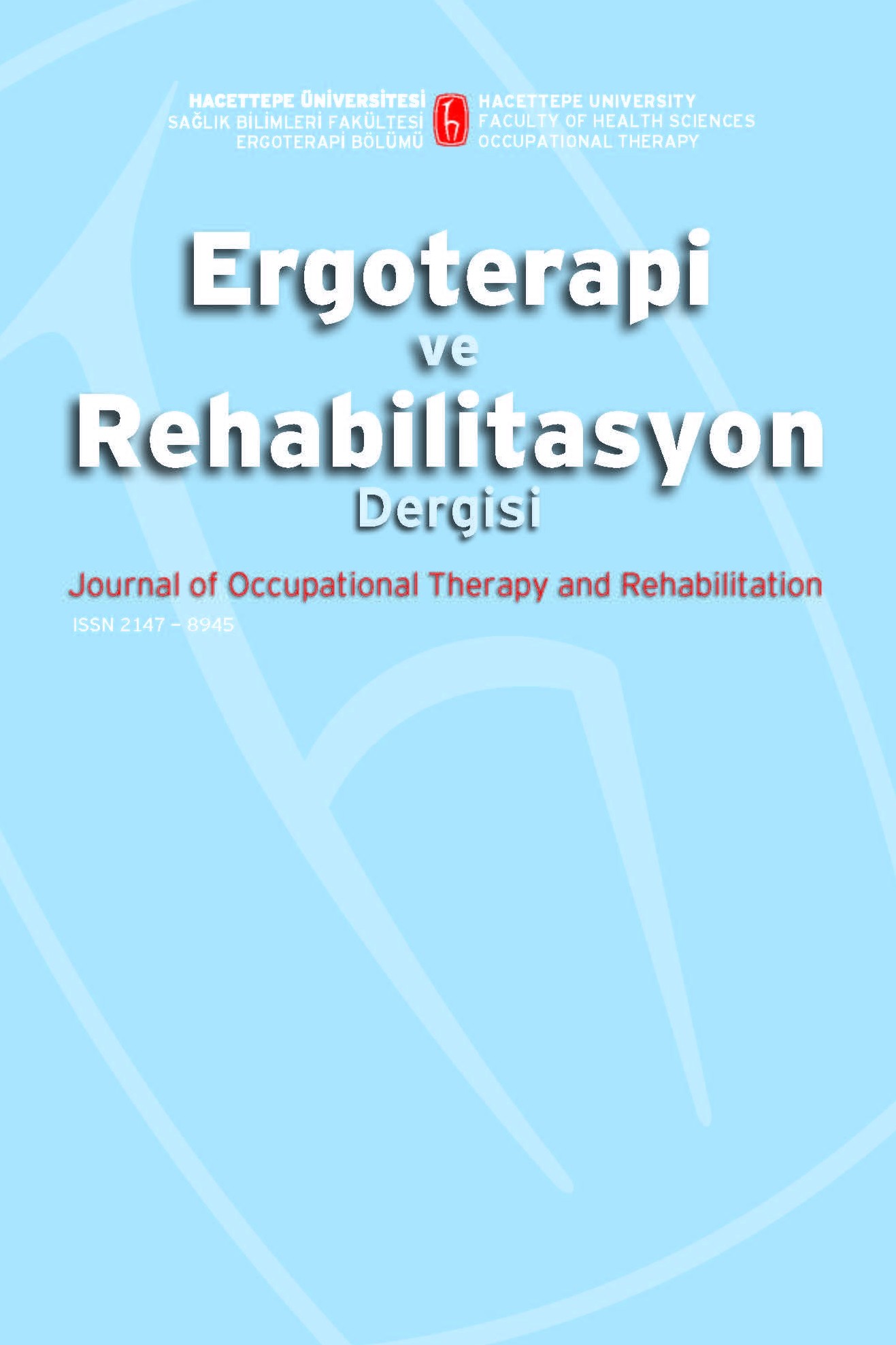İnsan Aktivite Modeli Temelli Ergoterapi Müdahalesinin Aile İçi Şiddet Yaşayan Kadınlarda Etkinliği
Ergoterapi, Aile içi şiddet, Kadınlar, İnsan aktivite modeli
The Effectiveness of Model of Human Occupation-Based Occupational Therapy Intervention for Women who Experienced Domestic Violence
Occupational therapy, Domestic violence, Women, Model of human occupation,
___
- Baron, K., Kielhofner, G., Iyenger, A., Goldhammer, V., & Wolenski, J. (2006). A User's Manual for the Occupational Self Assessment (OSA). (Version 2.2) Chicago, IL: University of Illinois.
- Cage, A. (2007). Occupational therapy with women and children survivors of domestic violence: are we fulfilling our activist heritage? A review of the literature. Br J Occup Ther, 70(5), 192-198. https://doi.org/10.1177/03080226070700050
- Carlson, B. E. (1997). A stress and coping approach to intervention with abused women. Fam Relat, 46(3), 291-298. https://doi.org/10.2307/585127 Cole, M. B., & Tufano, R. (2008). Applied theories in occupational therapy: A practical approach. Thorofare, NJ: Slack.
- d'Ardenne, P., & Balakrishna, J. (2001). Domestic violence and intimacy: what the relationship therapist needs to know. Sex Relat Therapy, 16(3), 229-246. https://doi.org/10.1080/14681990123489
- Gorde, M. W., Helfrich, C. A., & Finlayson, M. L. (2004). Trauma symptoms and life skill needs of domestic violence victims. J Interpers Violence, 19(6), 691-708. https://doi.org/10.1177/0886260504263871
- Gutman, S. A., Diamond, H., Holness-Parchment, S. E., Brandofino, D. N., Pacheco, D. G., Jolly-Edouard, M., et al. (2004). Enhancing independence in women experiencing domestic violence and possible brain injury: an assessment of an occupational therapy intervention. Occup Ther Ment Health, 20(1), 49-79. https://doi.org/10.1300/J004v20n01_03
- Hammell, K. R. W. (2016). Empowerment and occupation: a new perspective: autonomisation et occupation: une nouvelle perspective. Can J Occup Ther, 83(5), 281-287. https://doi.org/10.1177/0008417416652910
- Helfrich, C. A., & Aviles, A. (2001). Occupational therapy's role with victims of domestic violence: assessment and intervention. Occup Ther Ment Health, 16(3-4), 53-70. https://doi.org/10.1300/J004v16n03_04
- Helfrich, C. A., Aviles, A. M., Badiani, C., Walens, D., & Sabol, P. (2006). Life skill interventions with homeless youth, domestic violence victims and adults with mental illness. Occup Ther Health Care, 20(3-4), 189-207. https://doi.org/10.1080/J003v20n03_12
- Helfrich, C. A., & Rivera, Y. (2006). Employment skills and domestic violence survivors: a shelter-based intervention. Occup Ther Ment Health, 22(1), 33-48. https://doi.org/10.1300/J004v22n01_03
- Helfrich, C. A., & Fogg, L. F. (2007). Outcomes of a life skills intervention for homeless adults with mental illness. J Prim Prev, 28(3-4), 313-326. https://doi.org/10.1007/s10935-007-0103-y
- Javaherian, H., Krabacher, V., Andriacco, K., & German, D. (2007). Surviving domestic violence: rebuilding one's life. Occup Ther Health Care, 21(3), 35-59. https://doi.org/10.1080/J003v21n03_03
- Javaherian-Dysinger, H., Krpalek, D., Huecker, E., Hewitt, L., Cabrera, M., Brown, C., et al. (2016). Occupational needs and goals of survivors of domestic violence. Occup Ther Health Care, 30(2), 175-186. https://doi.org/10.3109/07380577.2015.1109741
- Levendosky, A. A., & Graham-Bermann, S. A. (2001). Parenting in battered women: the effects of domestic violence on women and their children. J Fam Violence, 16(2), 171-192. https://doi.org/10.1023/A:1011111003373
- Marshall, C. A., Boland, L., Westover, L. A., Isard, R., & Gutman, S. A. (2021). A systematic review of occupational therapy interventions in the transition from homelessness. Scand J Occup Ther, 28(3), 171-187. https://doi.org/10.1080/11038128.2020.1764094
- Monahan, K., & O'Leary, K. D. (1999). Head injury and battered women: an initial inquiry. Health Soc Work, 24(4), 269-278. https://doi.org/10.1093/hsw/24.4.269
- Muñoz, J. P., Reichenbach, D., & Hansen, A. M. W. (2005). Project employ: engineering hope and breaking down barriers to homelessness. Work, 25(3), 241-252.
- Muñoz, J. P., Dix, S., & Reichenbach, D. (2006). Building productive roles: occupational therapy in a homeless shelter. Occup Ther Health Care, 20(3-4), 167-187. https://doi.org/10.1080/J003v20n03_11
- Parkinson, S., Forsyth, K., & Kielhofner, G. (2006). Model of Human Occupation Screening Tool (MOHOST). (Version 2.0). Chicago, IL: University of Illinois.
- Pekçetin, S., Salar, S., İnal, Ö., & Kayıhan, H. (2018). Validity of the Turkish Occupational Self Assessment for elderly individuals. OTJR, 38(2), 105-112. https://doi.org/10.1177/1539449217743457
- Thomas, Y., Gray, M., & McGinty, S. (2011). A systematic review of occupational therapy interventions with homeless people. Occup Ther Health Care, 25(1), 38-53. https://doi.org/10.3109/07380577.2010.528554
- Zakarneh, M. (2015). Ankara Umut Evlerinde Kalan Bireylerin Aktivite-Rol Katılımı Açısından Ergoterapi Modeline Göre İncelenmesi. (Yüksek lisans tezi). Hacettepe Üniversitesi Sağlık Bilimleri Enstitüsü, Ankara.
- ISSN: 2147-8945
- Yayın Aralığı: 3
- Başlangıç: 2013
- Yayıncı: Hacettepe Üniversitesi Sağlık Bilimleri Fakültesi
Selma ERCAN DOĞU, Ayşe Gökçen GÜNDOĞMUŞ
Başar ÖZTÜRK, Ekin AKPINAR, Remziye AKARSU, Yusuf ÇELİK
İnsan Aktivite Modeli Temelli Ergoterapi Müdahalesinin Aile İçi Şiddet Yaşayan Kadınlarda Etkinliği
Yetişkin Bireylerde Zaman Yönetimi ve Yaşam Kalitesi Arasındaki İlişki
Kekemelik için kendini açma ifadeleri: Nitel öz bildirim çalışması
Hanife ABAKAY, Duygu Sultan ÖGE, Türkan AKBAYRAK
Fatma Nur KOCADEMİR, Medine Nur ÖZATA DEĞERLİ, Onur ALTUNTAŞ
